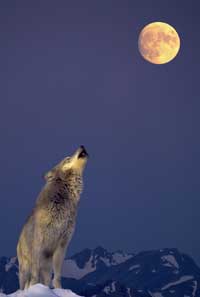During the 1970s oil shale boom, the Carter Administration considered Western Colorado a “national sacrifice zone.” Western Slope residents often consider themselves victims of policies that would sacrifice our communities and economies on the altar of urban politics. During the decade I was president of Club 20, Denver friends occasionally accused us of acting like Western Colorado was the “poor picked-on stepchild.” We answered simply, “History is on our side.”
Once again, Western Colorado is in the cross hairs of a national debate, this time about a wildlife issue that normally brings people together, namely, the restoration of endangered species. Colorado boasts of some of conservation’s greatest success stories, with recovering populations of lynx, moose, bighorn sheep, prairie chickens, river otters, peregrine falcons, mountain goats, cutthroat trout, and many others. But this time, the dispute is about a proposal to reintroduce wolves, and support is far from unanimous.
 A ballot measure, called “Initiative 79,” has been started by the Rocky Mountain Wolf Project and Rocky Mountain Wolf Action Fund, both funded by out-of-state interests (Ted Turner, the Sierra Club and the San Francisco-based Tides Center). The initiative will be on the 2020 ballot if backers get the required signatures, which is likely with any effort so well-funded.
A ballot measure, called “Initiative 79,” has been started by the Rocky Mountain Wolf Project and Rocky Mountain Wolf Action Fund, both funded by out-of-state interests (Ted Turner, the Sierra Club and the San Francisco-based Tides Center). The initiative will be on the 2020 ballot if backers get the required signatures, which is likely with any effort so well-funded.
I have advocated restoring absent species for many years, and am proud of the small role I played in some of those successes. There is a difference, though, with wolves, grizzlies, and other species that do not peacefully coexist with humans. Colorado may still be prime habitat for such species, but it is also home to 2.8 million cows, 365,000 sheep, 282,000 elk, a half-million deer, and five million people. Those facts cannot be separated.
Advocates for wolf reintroduction always claim predation of livestock and big game are exaggerated. One Sierra Club official blames a “small and vocal group of ranchers,” spreading myths. She said, “Ranchers have been living and doing well with wolves on the landscape up in Canada and Montana and Idaho for many decades.” Most ranchers certainly do not think so. The Department of Agriculture says wolves kill about 10,000 cows and 1,300 sheep a year.
Proponents say wolves help “restore balance” to the ecosystem, but the Rocky Mountain Elk Foundation worries that they may also decimate elk populations. We know when wolves were reintroduced in Yellowstone between 1995 and 2004, the elk population declined by half. Colorado Parks and Wildlife has always opposed wolf reintroduction, because of such conflicts.
The most worrisome conflict, though, is with people. The International Wolf Center website says, “There has not been a person killed by wolves in North America during the 20th century.” But the group also claims wolves have been nearly extinct since then, so obviously documented attacks are rare. When wolves are plentiful, so are wolf attacks. France kept track for three centuries and recorded 3,069 people killed by wolves. In Italy an average of one person was killed by wolves every year for 400 years. In North America there were no records before European settlement, but there was substantial Native American folklore about wolf attacks.
There are more than 40 reported wolf attacks in the U.S., beginning with Daniel Boone and Nathaniel Gist, Sequoya’s father, who were attacked by wolves in 1761 and barely escaped alive. Thirteen trappers encamped in Wyoming were attacked in 1833, and in 1881 a Colorado woman was attacked by a wolf. Wolves killed 25-year-old Patricia Wyman in Ontario in 1996, Kenton Carnegie in Saskatchewan in 2005, and Candice Berner, an Alaska jogger, in 2010. In 2000 two young boys were attacked in Alaska, and a 23-year-old man was attacked while camping in British Columbia. In 2013, a teenager was attacked and seriously wounded in his sleeping bag in Minnesota.
A federal “Wolf Conservation Area” was established in northern Colorado in 2016, ranging from I-25 west to Craig, and from I-70 north to Wyoming. It includes all of Grand, Jackson, Gilpin and Boulder counties and parts of Moffat, Routt, Eagle, Summit, Clear Creek, Jefferson, Adams and Larimer. Logically, you might expect that to be the area selected for reintroduction of wolves. But no – “Initiative 79” specifies that the releases all must be on the Western Slope. Not in Boulder, Adams, Jefferson, or Larimer counties, only “west of the Continental Divide.”
Advocates insist that these human conflicts are overblown – maybe so. There is one easy way to test that theory, or at least to determine how strongly they believe it. Introduce the new wolf population in their communities first.
This column originally appeared in the Grand Junction Daily Sentinel May 17, 2019.




Comments on this entry are closed.